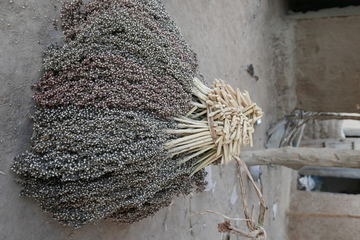Browse

Friction: the force and A few factors
Friction is the force that resists motion when the surface of one object comes in contact with the surface of another. The mechanical advantage of a machine is reduced by friction, or in other words, the ratio of output to input is reduced because of friction. An automobile uses one-quarter of its energy on limiting the friction. Yet, it is also friction in the tires that allows the car to stay on the road and friction in the clutch that makes it possible to drive. From matches to machines to molecular structures, friction is one of the most significant phenomena in the physical world.
A few factors affecting the frictional force:
These forces are mainly affected by the surface texture and amount of force impelling them together.
The angle and position of the object affect the amount of frictional force.
If an object is placed flat against an object, then the frictional force will be equal to the weight of the object.
If an object is pushed against the surface, then the frictional force will be increased and becomes more than the weight of the object.
Read more

By: rupali
Due Date: Oct, 30, 2024
Education
Leave a comment

STRATEGIC IEC/ COMMUNICATION PLAN
strategic framework for targeted IEC activities encompassing mass media, along with mid-media and inter-personal activities so as to disseminate information about the various health schemes in the masses. The year-long IEC/Communication Plan had month-wise focus on health days and health themes. While some activities were taken up to coincide with ‘Health Days’, others were week and month long plans for focussed multi-media campaigns on schemes of the Ministry. These centered around topics such as Integrated Diarrhoea Control Fortnight (IDCF), Breastfeeding Week, Tobacco Control etc. Seasonal ailments such as Dengue, H1N1 etc., needed campaigns for a longer time
The objective is also to encourage build-up of health seeking behaviour among the masses in keeping with the focus on promotive and preventive health. The IEC strategy has catered to the different needs of the rural and urban masses through the various tools used for communication
Read more

By: rupali
Due Date: Jan, 3, 2022
Water, energy, and the...
+1
Leave a comment

Natural plant products
Natural plant products have been used throughout human history forvarious purposes. Having co-evolved with animal life, many of the plants fromwhich these natural products are derived are billions of years old. Tens ofthousands of these products are produced and discovered since. Dyes areone of them. Fabric dye has been one of the common things used in these moderndays. But using it has also disadvantages to the environment. Therun-offfrom fabric dye pollutes water ways, and the dyes themselves are not sohealthy for workers who are around them day in and day out, either.There areways to prevent these harmful effects of using dye to both the environmentand human beings, and that is by using organic substances instead ofcommercialized products which utilizes toxic ingredients.
Read more

By: rupali
Due Date: Jun, 1, 2028
Agri-food systems
+1
Leave a comment

Lorem Ipsum: Where does it come from?
Contrary to popular belief, Lorem Ipsum is not simply random text. It has roots in a piece of classical Latin literature from 45 BC, making it over 2000 years old. Richard McClintock, a Latin professor at Hampden-Sydney College in Virginia, looked up one of the more obscure Latin words, consectetur, from a Lorem Ipsum passage, and going through the cites of the word in classical literature, discovered the undoubtable source. Lorem Ipsum comes from sections 1.10.32 and 1.10.33 of "de Finibus Bonorum et Malorum" (The Extremes of Good and Evil) by Cicero, written in 45 BC. This book is a treatise on the theory of ethics, very popular during the Renaissance. The first line of Lorem Ipsum, "Lorem ipsum dolor sit amet..", comes from a line in section 1.10.32. The standard chunk of Lorem Ipsum used since the 1500s is reproduced below for those interested. Sections 1.10.32 and 1.10.33 from "de Finibus Bonorum et Malorum"
Read more

By: Edwin Castel
Due Date: Jan, 21, 2022
Education
Leave a comment

Venture capital
Primer text from The College of William & MaryADHD is one of the most commonly diagnosed conditions of children (Centers for DiseaseControl and Prevention, 2015).
In a 2016 Centers for Disease Control and Prevention study, scientists found that 6.1 million children aged 2-17 years living in the U.S. had been diagnosed with attention-deficit/hyperactivity disorder (ADHD), which is similar to previous estimates.
Ages 2-5: Approximately 388,000 children
Ages 6-11: Approximately 2.4 million children
Ages 12-17: Approximately 3.3 million children
The diagnostic term attention deficit/hyperactivity disorder (ADHD) refers to individuals who display patterns of inattention, impulsivity, and overactive behavior that interfere with daily functioning (American Psychiatric Association [APA], 2013).
The Diagnostic and Statistical Manual (DSM) V (APA, 2013) criteria for diagnosing ADHD listthree types of ADHD and the accompanying characteristics.
Predominantly inattentive type.The student may:o submit inaccurate or incomplete work,o have difficulty attending to conversations, activities, or tasks,o be easily distracted,o have difficulty following directions,o frequently lose materials, and/oro have difficulty organizing tasks and materials.
Read more

By: Anne miller New vijayalaxmi sant...
Due Date: Aug, 7, 2021
Culture and society
+1
Leave a comment

Plant sterols
Plant sterols are found in the highest amounts in foods like vegetable oils, nuts, and seeds. Plant sterols are used as medicine. Plant sterols are most commonly used for lowering.
Plant sterols are a group of substances made in plants. Plant sterols are found in the highest amounts in foods like vegetable oils, nuts, and seeds. Plant sterols are used as medicine.Plant sterols are most commonly used for lowering cholesterol levels. Plant sterols are also used for other conditions, but there is no good scientific evidence to support these other uses.
Read more

By: rupali
Due Date: May, 27, 2021
Water, energy, and the...
+1
Leave a comment

Regenerative Organic Agriculture
Regenerative agriculture is a conservation and rehabilitation approach to food and farming systems. It focuses on topsoil regeneration, increasing biodiversity.
Regenerative agriculture is a conservation and rehabilitation approach to food and farming systems. It focuses on topsoil regeneration, increasing biodiversity, improving the water cycle, enhancing ecosystem services, supporting biosequestration, increasing resilience to climate change, and strengthening the health and vitality of farm soil.
Regenerative agriculture is an adaptive management approach that is supported by soil health principles. There is no recipe or prescription because each farm or ranch differs based on unique natural resources, climate variability, and animal and ecological dynamics.
Regenerative agriculture practices are designed to reduce inputs of synthetic fertilizers and pesticides, increase soil organic matter, enhance biodiversity and restore ecosystems, particularly optimizing the hydrological cycle. While the general public knows little about the crisis of soil loss, there is awareness and concern regarding the climate crisis. The two are connected and the recent surge of interest in regenerative agriculture has been stimulated by the hope of climate resilience and carbon sequestration offered by regenerative agriculture.
Climate change mitigation has focused mainly on cutting carbon emissions and replacing fossil fuels with renewable energies. But more recently, carbon sequestration has come into the spotlight. The potential for agricultural practices to draw down and absorb carbon in the soil has begun to receive more attention.
Read more

By: rupali
Due Date: Sep, 30, 2022
Agri-food systems
Leave a comment

How Sociologists Define Culture
Culture is one of the most important concepts within sociology because sociologists recognize that it plays a crucial role in our social lives. It is important for shaping social relationships, maintaining and challenging social order, determining how we make sense of the world and our place in it, and in shaping our everyday actions and experiences in society. It is composed of both non-material and material things.
In brief, sociologists define the non-material aspects of culture as the values and beliefs, language, communication, and practices that are shared in common by a group of people. Expanding on these categories, culture is made up of our knowledge, common sense, assumptions, and expectations. It is also the rules, norms, laws, and morals that govern society; the words we use as well as how we speak and write them and the symbols we use to express meaning, ideas, and concepts (like traffic signs and emojis, for example). Culture is also what we do and how we behave and perform (for example, theater and dance). It informs and is encapsulated in how we walk, sit, carry our bodies, and interact with others; how we behave depending on the place, time, and "audience;" and how we express identities of race, class, gender, and sexuality, among others. Culture also includes the collective practices we participate in, such as religious ceremonies, the celebration of secular holidays, and attending sporting events.
Read more

By: rupali
Due Date: Jan, 18, 2025
Culture and society
+2
Leave a comment

Human activity affects and Global warming, the phenomenon
Human activity affects global surface temperatures by changing Earth's radiative balance—the “give and take” between what comes in during the day and what Earth emits at night. Increases in greenhouse gases—i.e., trace gases such as carbon dioxide and methane that absorb heat energy emitted from Earth's surface and reradiate it back—generated by industry and transportation cause the atmosphere to retain more heat, which increases temperatures and alters precipitation patterns.
Global warming, the phenomenon of increasing average air temperatures near the surface of Earth over the past one to two centuries. Climate scientists have since the mid-20th century gathered detailed observations of various weather phenomena (such as temperatures, precipitation, and storms) and of related influences on climate (such as ocean currents and the atmosphere’s chemical composition).
Read more

By: rupali
Due Date: May, 12, 2023
Water, energy, and the...
+1
Leave a comment

Data Tag Implementation
Recipes is the fifth format we support, following the introduction of reviews, people, video and, most recently, events.If you have recipe content on your site, you can get started now by marking up your recipes with microdata, RDFa, or the hRecipe microformat. To learn more, read our documentation on how to mark up recipe information or our general help articles on rich snippets for a more complete overview.Please remember that to ensure a great user experience we're taking a gradual approach to surface rich snippets. This means that we can't guarantee that marking up your site will result in a rich snippet when your page shows up on our search results. However, we encourage you to get started, and once you're done you can test your pages with our rich snippets testing tool.Written by Jun Gong, Kosuke Suzuki, and Yu Watanabe
Read more

By: Jen Martins Henzansanath
Due Date: Jul, 9, 2021
Agri-food systems
+2
Leave a comment
No Preview Available
Agri and food Scholar
Primer text from The College of William & MaryADHD is one of the most commonly diagnosed conditions of children (Centers for DiseaseControl and Prevention, 2015).
In a 2016 Centers for Disease Control and Prevention study, scientists found that 6.1 million children aged 2-17 years living in the U.S. had been diagnosed with attention-deficit/hyperactivity disorder (ADHD), which is similar to previous estimates.
Ages 2-5: Approximately 388,000 children
Ages 6-11: Approximately 2.4 million children
Ages 12-17: Approximately 3.3 million children
The diagnostic term attention deficit/hyperactivity disorder (ADHD) refers to individuals who display patterns of inattention, impulsivity, and overactive behavior that interfere with daily functioning (American Psychiatric Association [APA], 2013).
The Diagnostic and Statistical Manual (DSM) V (APA, 2013) criteria for diagnosing ADHD listthree types of ADHD and the accompanying characteristics.
Read more

By: Anne miller New vijayalaxmi sant...
Due Date: May, 1, 2021
Health and nutrition
Leave a comment

agriculture scholarship
If a student is not responsive to behavioral strategies and interventions, more intensive interventions, such as functional behavior assessment and behavior intervention plans, should be considered (see Practical FBA).
No one intervention is universally effective for all students with ADHD. A combination of research-based and promising practices is recommended.
Here are several of these practices:
Giving DirectionsMany students with ADHD have trouble following directions. Here are some guidelines that might help address this problem.
Number of Directions: Give a minimal number of directions or steps at a time.If necessary, have students repeat the directions to the teacher or a peer partner.
Form of Directions: Provide written directions or steps, or a visual model of acompleted project. Teach students how to refer to these items as reminders ofprocess steps to complete tasks. This strategy is particularly helpful for long-termprojects.
Written AssignmentsMany students with ADHD have particular challenges with written work due to finemotorskills difficulties, motor planning issues, and difficulty alternating their attentionfrom a book to their written responses.
Read more

By: Anne miller New vijayalaxmi sant...
Due Date: Jun, 25, 2021
Agri-food systems
+1

Leave a comment